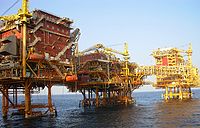Mumbai High Field: Difference between revisions
Adityabadami (talk | contribs) No edit summary |
Adityabadami (talk | contribs) No edit summary |
||
| Line 1: | Line 1: | ||
[[File:ONGC Oil Platform.jpg|thumb|right|200px|ONGC platform at Bombay High in the [[Arabian Sea]]]] |
[[File:ONGC Oil Platform.jpg|thumb|right|200px|ONGC platform at Bombay High in the [[Arabian Sea]]]] |
||
[[Image:Solitary Oil Rig In The Arabian Sea.jpg|200px|thumb|Oil Rig at Bombay High]] |
[[Image:Solitary Oil Rig In The Arabian Sea.jpg|200px|thumb|Oil Rig at Bombay High]] |
||
'''Bombay High''' |
'''Bombay High''' is an offshore [[oilfield]] 160 km off the coast of [[Bombay]]. The oil operations are run by India's [[Oil and Natural Gas Corporation]] ([[ONGC]]). |
||
Bombay High field was discovered by a Russian and Indian oil exploration team operating from the seismic exploration vessel Academic Arkhangelsky during mapping of the Gulf of Khambat (earlier Cambay) in 1964-67. The naming of the field is attributed to a team including Mr. M. Krishnamurthy, from a survey run in 1965 analysed in the Rashmi building in [[Peddar Road]], Cumballa Hill, Bombay. The first offshore well was sunk in 1974. |
Bombay High field was discovered by a Russian and Indian oil exploration team operating from the seismic exploration vessel Academic Arkhangelsky during mapping of the Gulf of Khambat (earlier Cambay) in 1964-67. The naming of the field is attributed to a team including Mr. M. Krishnamurthy, from a survey run in 1965 analysed in the Rashmi building in [[Peddar Road]], Cumballa Hill, Bombay. The first offshore well was sunk in 1974. |
||
Revision as of 11:11, 20 May 2011


Bombay High is an offshore oilfield 160 km off the coast of Bombay. The oil operations are run by India's Oil and Natural Gas Corporation (ONGC).
Bombay High field was discovered by a Russian and Indian oil exploration team operating from the seismic exploration vessel Academic Arkhangelsky during mapping of the Gulf of Khambat (earlier Cambay) in 1964-67. The naming of the field is attributed to a team including Mr. M. Krishnamurthy, from a survey run in 1965 analysed in the Rashmi building in Peddar Road, Cumballa Hill, Bombay. The first offshore well was sunk in 1974.
Every oil resource rock requires oil trap structures which are mainly salt dome, coral reefs, fault trap and fold trap. In case Bombay high it is anticlinal fold trap and this is the most probable reason to call it "Bombay high".
Production
As of 2004, it supplied 14% of India's oil requirement and accounted for about 38% of all domestic production.
On 27 July 2005, a major fire destroyed the production platform, leaving at least 11 people dead despite rescue measures taken by the Indian Coast Guard. The platform accounted for 110,000 barrels per day (17,000 m3/d), or 15%, of India's oil production. Rebuilding this is expected to take upwards of 4 months and estimated to cost around Rs. 1200 crore or US$300 million.
Crude oil produced from Bombay High is of very good quality as compared to crudes produced in middle east. Bombay High crude has more than 60% paraffinic content while light Arabian crude has only 25% paraffin.[1]
In November 2009 , output at ONGC's Bombay High fields, that accounts for half of the domestic annual oil production, fell 5.3 per cent to 1.421 million tonne (3,47,197 barrels per day). [2]
References
- ^ "Billingual-Home". ONGC. Retrieved 2010-08-14.
- ^ "November gas production up 47.6%, crude oil down 1.5%". The Hindu Business Line. 2009-12-25. Retrieved 2010-08-14.
19°25′00″N 71°20′00″E / 19.41667°N 71.33333°E Template:Bombay topics
